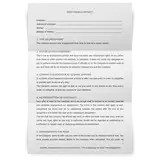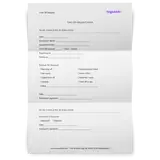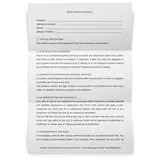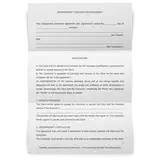Download FREE Service Level Agreement (SLA) Template
What is a service-level agreement?
Service-Level Agreement or an SLA is a contract between a service provider and its customer. The customer can be either internal or external, depending on the organization and service arena. Through an SLA, a service provider states the terms that they can do the required work. An SLA helps service providers describe the scope of work and by doing so exempts them from any unwanted liability.
For customers, an SLA gives them a clear idea about the work that can be done and any exclusions, which helps them compare the service provider with others and make an informed decision.
It describes the level of service that someone can get out of a business relationship, including the quality of service performance, resolution times, unscheduled service outages, the hours of operation and all the other relevant details for the relevant parties on both sides of the agreement.
What does a service-level agreement consist of?
A basic Service-Level Agreement acts like a list, which usually defines what work can be done and what is excluded. Through this agreement, both parties are informed about the duties and scope of work that is to be done, so that the client can get their service expectations in order.
Implementation
In an SLA, covers the scope of work. The service provider lists out the activities that are involved in the implementation of the services and the level of support offered by the service provider. This part of the legal agreement is crucial for getting potential customers on board instead of heading to a direct competitor.
Performance
An SLA consists of performance metrics that list outcomes and certain agreed-upon outputs that are expected from both parties. It outlines the service type and service availability and all other critical details that can convince the client to sign. This is a mutual agreement on the performance standards provided by the independent contractor - the minimum level of performance that keeps customers happy.
Financial requirements
The service agreement has to mention financial arrangements such as fee structures, adjustments, hikes, etc. Complete transparency is expected while listing out any variable factors. The sales department can give you all the payment details in this part of the legal document.
Operational responsibilities
The activities that fall on the service provider that is relevant to the operational requirements of the service. For example, if the vendor provides remote assistance on a regular basis.
Governance
Questions like ‘Who does what? Why? Who answers for results? Who decides what?’ are answered in the agreement. This is a key element in every vendor relationship because all sets of customers need to know who is responsible for them on a monthly basis.
This part of the binding agreement also discusses what happens in cases such as natural disasters.
FAQ on service level agreement
If you have any questions, check out the answers below.
What are service level agreements?
Service level agreements (SLAs) are contracts between a service provider and a customer. With Unrubble's service level agreement template, you outline service levels, appropriate service support responsibilities, and performance measures. This agreement makes sure both parties understand the service provision and what to expect.
What should a service level agreement template include?
A service level agreement template includes service levels, service support responsibilities, and a service level performance measure. It also covers the primary support provider, service credits for unmet standards, and the entire agreement's terms. The template sets clear expectations for both parties.
How do service credits work in an SLA?
Service credits offer compensation when the primary support provider does not meet the service level performance criterion. They ensure appropriate service support by defining assistance related to service provision if standards fall short.
![Service Level Agreement (SLA) - Free Template (Word) [Download]](/static/image?src=https%3A%2F%2Fcdnblog.unrubble.com%2Fpayload-unrubble-images%2FService-Lever-Agreement-SLA-Template-1-600x600.png&width=512&height=512&fit=contain&position=center&quality=65&compressionLevel=9&loop=0&delay=100&crop=null&contentType=image%2Fwebp)




